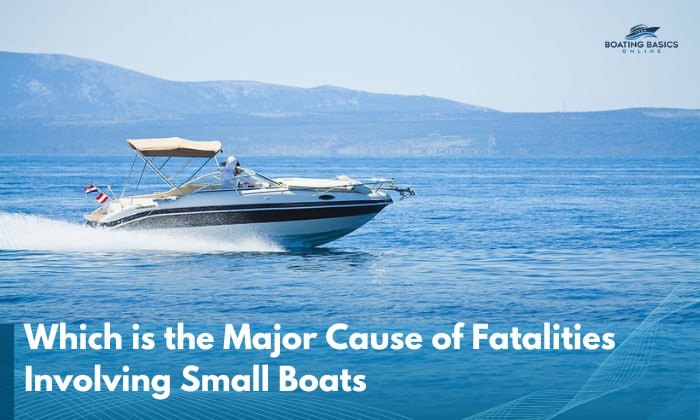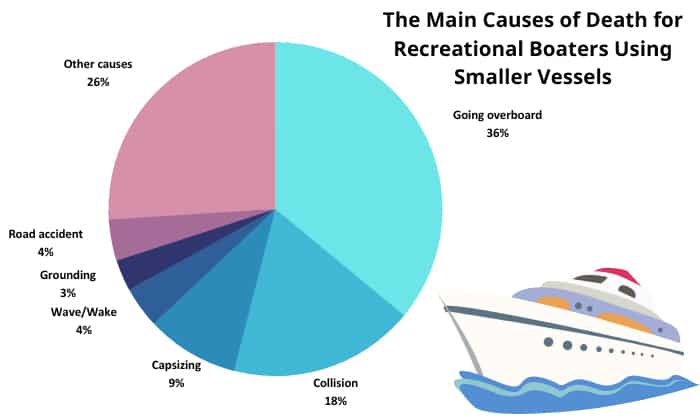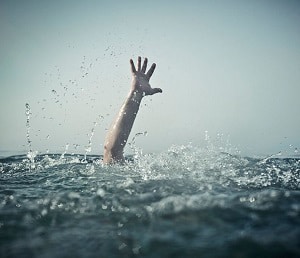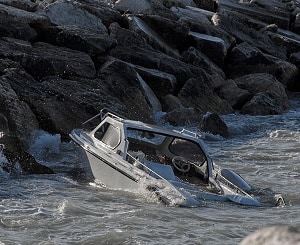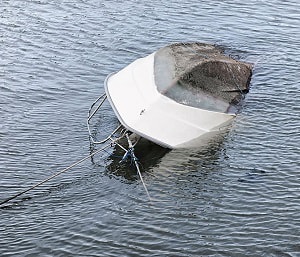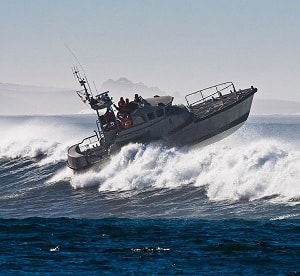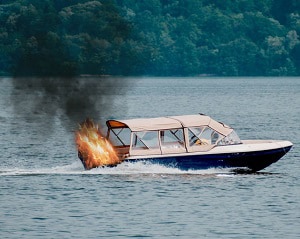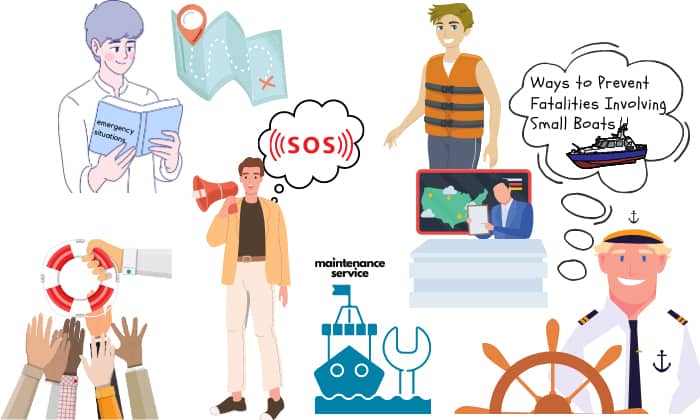If you’ve been in the boating industry for a while now, you probably already know that more people got interested in owning boats during the pandemic. Unfortunately, along with this rise came a deadly consequence: boating fatalities surged by more than 25% compared to 2019.
In 2020, 80% of the fatalities occurred in small recreational vessels (21 feet and below). Naturally, this leads us to the question, “Which is the major cause of fatalities involving small boats?”
Unsurprisingly, it’s caused by drowning, mainly due to going overboard, collisions, or capsizing.
Here’s a breakdown of the most common causes of fatalities:
Table of Contents
The Main Causes of Death for Recreational Boaters Using Smaller Vessels
When a small open boat capsizes or has an accident, there are a lot of tell-tale clues that we can look at. Naturally, we want to look at the hard data as much as possible. Below is the major cause of fatalities involving small vessels.
1. Going overboard
Stats show that 36% of fatalities are caused by falling overboard, which is the highest. Reckless behavior tends to be what cause someone to fall overboard, be it from the passengers or the boat operator, who usually lack basic safety education.
It’s not just inadequate education that’s the issue; small boats tend to carry far fewer safety equipment like life jackets. It’s just that they have a limited carrying capacity due to their size. This is a big part of the reason 86% of victims who drowned in recent years weren’t wearing life jackets.
Incidentally, the person falling into the water is at risk of being hit by propellers, which is potentially fatal, regardless of vessel size. In fact, in 2020, 39 deaths occurred from propeller-related injuries alone.
As a result, going overboard becomes the type of boating emergency that causes the most fatalities.
2. Collision
18% of fatalities are tied to collisions. That’s not really surprising as it could arise from various causes, like poor weather conditions, low visibility, skipper error, and equipment failure.
Not to mention, most small boat operators are inexperienced and lack basic safety education, which can ultimately lead to deadly collisions. In fact, the majority of fatalities from boating accidents are linked to this particular drawback.
What’s more, alcohol is another major cause of deaths involving small boats. In 2021 alone, 658 boating-related deaths listed the operator as driving under the influence.
3. Capsizing
Recreational and sailboat capsizing resulted in 9% of fatalities. It’s not just because the passengers in a capsized boat can get thrown overboard, but they may also suffer traumatic injuries once the accident happens.
So why are small-sized watercraft prone to capsizing? This is because the innately lower weight capacity of boats of this limited size makes them more prone to capsizing. This means it’s easy to overload them, which causes a boat to capsize.
As you can see, drowning became and continues to be a major cause of deaths involving small boats due to a combination of long-standing issues prevalent among recreational boat owners.
There’s a clear problem in adherence to and a lack of knowledge of the basic safety guidelines. And unfortunately, tinier vessels also have a natural disadvantage that simply makes them more prone to untoward events while out in the open waterways.
4. Wave/Wake
Waves or the wakes caused by boats are tied to 4% of fatalities, similar to both grounding and road accidents. These two can both cause collisions, capsizing, and passengers going overboard.
5. Grounding
Grounding could also cause any of the three major accidents said above. Moreover, there’s the possibility for it to damage parts of the boat, which could cause flooding and, in turn, drowning.
6. Road accident
The figures attribute 4% of deaths to road accidents. Not surprising, since 1 out of 103 people out on the road dies from it in the US.
7. Other causes
26% of fatalities are attributed to other causes, such as bad weather, human errors, and negligence.
For instance, small boats with motor engines are at risk of fires, which can quickly become out of control. If your boat has rotted or moldy wood, the fire can turn deadly even faster, whereas fiberglass boats will release toxic smells when burned.
Jumping into the water in the event of a boat fire doesn’t mean you’re safe, either. You can get hypothermia, and if you’re too far away from the shore, swimming to safety can prove next to impossible.
Ways to Prevent Fatalities Involving Small Boats
Thankfully, this problem can be addressed directly through prevention. By being mindful of what steps you should take to reduce the chances of fatalities, you’re already giving yourself and your passengers an immense advantage that should safeguard them and put everyone’s minds at ease.
1. Bring enough life jackets aboard and encourage everyone to wear them at all times while they’re onboard. If you’re an adult, you may be embarrassed to learn that 65% of children wear a life jacket compared to the lowly 12% among adults.
2. Never skip hitting the books, especially if you’re still not familiar with what to do during emergency situations. As you continue to learn, make sure you actually put them into practice.
3. Every boat operator should know the answer to, “What should you do once a boat gets swamped far from shore?”
To be clear, you should know that you must stay with the boat and signal for help when the opportunity presents itself. As such, you should know what signals to use and how to use tools for that purpose.
4. Conversely, you should know what to do to help others who are in need of aid. Keep in mind that the primary responsibility for a vessel operator assisting a boat in distress is to keep everyone aboard their boat safe, first and foremost.
5. Avoid going out during inclement weather as much as possible. Unless you’re 100% confident that your vessel can handle higher-than-normal waves and stronger winds, don’t risk it!
6. Familiarize yourself with the waterways you frequent. You should be able to readily gauge whether it’s wise or not to push your small vessel to the limit in any given situation or maritime and weather conditions.
7. Never skimp on your boat’s regular maintenance. Check the prop and engine for possible problems you may regret early on. Prepare a checklist that includes safety procedures (and, yes, this includes making sure you’re bringing enough life jackets!)
Conclusion
So to summarize the answer to the question that has been making the rounds online, “EP-31 Which is the major cause of fatalities involving small boats?” it’s because people are more likely to drown when riding them. As for why this is so, the issue can’t be pinpointed to a single cause.
There are factors that more or less compound to make them the accident-prone vessels that they are. Sadly, having such a label automatically ties them to a higher fatality rate. This is why it’s highly encouraged for boat owners to take proactive steps in mitigating that risk.

“My intention from the first day establishing Boating Basics Online is to provide as much help as possible for boaters who want to experience a first safe and convenient trip. So feel free to join us and share your beautiful journeys to the sea!”

